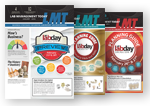FINAL RESULT
I was pleased with the final texture and reflection of the light on the restoration. The custom ceramic shade tabs were essential in achieving an accurate color match with the patient’s natural dentition. You can also see the excellent tissue management by the clinician, Dr. Cary Goldberg. The final restoration met the patient’s esthetic expectations and she was very pleased with her smile.STEP 2
After the tooth was prepped, I checked the prep color. To cover the dark stump shade, I decided to use a B1-base zirconia coping. Also, the gingival third had a high value and would require more dentin color. In the occlusal view, you can see the 1.2-mm facial area with proper lingual reduction.
The impression was scanned using a Freedom Scanner from DOF and a zirconia coping was milled in-house using the Amann Girrbach Ceramill Motion 2.STEP 1
At a custom-shade appointment, I checked the color and facial thickness of tooth #9. I used my Custom Shade Chart* to record the contour and a bright reflection in the convex area of the tooth, as well as the texture, shape, and horizontal and vertical lines. I also took into consideration the surface texture between the lobe and the final external stain. I drew a color map of the tooth, dividing it into five segments: gingival, middle, incisal third and mesial/distal corners.
I used three custom porcelain shade tabs—Y13, Y7 and Y1—from the LSK121 Chairside Shade Guide* to check the translucency, white calcification, warm tone of the gingival and interproximal area, and the incisal third color.
* To download the Custom Shade Chart or for more information on the LSK121 Chairside Shade Guide, visit LMTmag.com/articles/how-to-maximize-custom-shade-matching-results.






















